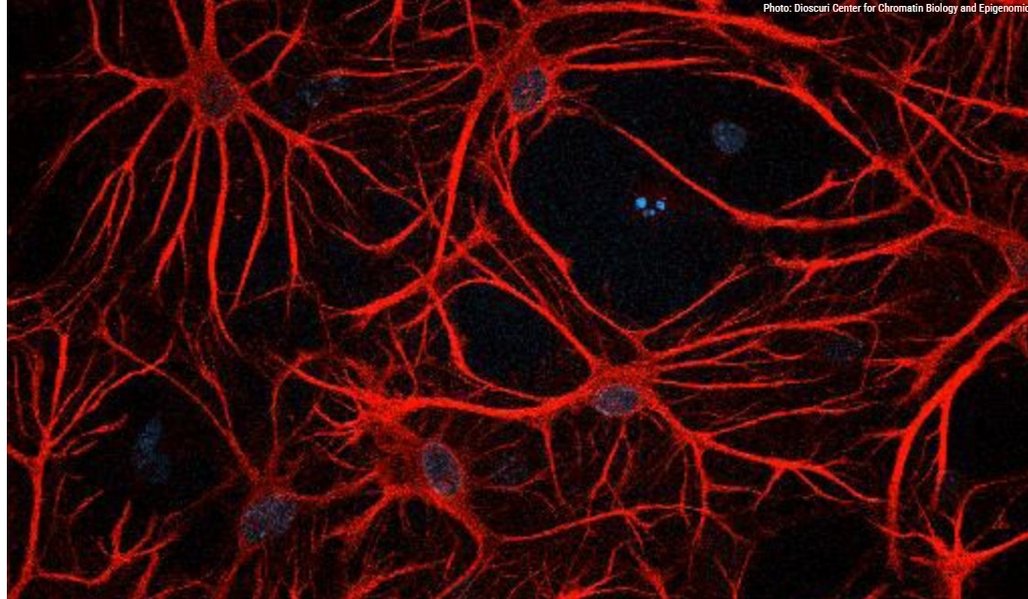Astrocytes appear to play a more important role in the evolution of the brain than previously thought. A team of researchers led by Aleksandra Pękowska from the Nencki Institute of Experimental Biology in Warsaw has discovered new genes and mechanisms that contribute to this process. The study, in which Rüdiger Behr from the German Primate Center was also involved, was published in the journal Cell Stem Cell.
Astrocytes are star-shaped cells in brain tissue. Unlike neurons, they do not conduct electrical signals. Their task is to form the blood-brain barrier and maintain the right environment in the brain tissue by regulating the pH value or ion concentration, among other things. Astrocytes also supply the neurons with nutrients and remove metabolic waste products. Furthermore, astrocytes contribute to the formation and breakdown of synapses and supply the substances necessary for the production of neurotransmitters, which are crucial for neuronal activity. “You could call them the guardians of the brain. There is practically no neurological disease that is associated with disorders of astrocyte biology,” says Aleksandra Pękowska, the lead author of the study.
Previous studies have shown striking differences in the morphology of astrocytes in mice, monkeys and humans. Human cells are the largest and most complex compared to other species, suggesting possible evolutionary changes in astrocyte function. Previous work, while informative, has been primarily descriptive and focused on astrocytes from mature individuals. However, the fetal period of human life is not only a critical time for brain development, but also shapes future brain function. Many genes known to affect cognition are already or exclusively active at this stage.
In their investigations, the scientists therefore focused on fetal astrocytes. They obtained these cells from induced pluripotent stem cells. Using transcriptomics, they discovered that a very high percentage of genes that are more active in human astrocytes than in chimpanzee or macaque astrocytes are involved in the formation of extracellular vesicles (EV).
EVs are microscopic biological structures that are released by living cells into the extracellular space. They are present in all body fluids. EVs do not replicate but serve for intercellular communication and can contain a variety of molecules such as proteins, lipids, DNA or RNA. EVs appear to be essential for the proper development of neurons.
As the effect of EVs on astrocytes has been insufficiently researched, the researchers wanted to test how vesicles secreted by human astrocytes influence macaque cells. “It turned out that the monkey cells became larger and more complex under the influence of the human EVs,” says Rüdiger Behr, head of the Research Platform Stem Cell Biology and Regeneration at the DPZ. “This means that the particles transferred some information that may contribute to the development of astrocyte morphology. However, the mechanism underlying this phenomenon is still unclear.”
The study also found that genes associated with brain diseases are more often “silenced” than “activated” in human astrocytes compared to cells from monkeys. By switching off the disease-related genes, our brain gains additional functions. “We don't yet know what these functions are, but the gain of these functions is so valuable that our species is willing to pay a high price, namely the reduced ability to intercept changes that lead to a further reduction in the activity of these genes. What evolutionary advantage this gives us is still unclear and a focus of future research,” says Pękowska.
In collaboration with Prof. Bartosz Wilczyński from the University of Warsaw, the team combined molecular biology and computational tools, including artificial intelligence, to investigate how the genetic differences between humans and chimpanzees are linked to changes in gene expression between our two species. They found that evolutionary gene activation is linked to well-defined changes in the DNA sequence.
“The comparative monkey-human study shows interesting differences in brain development and which key processes we need to look at in the future to better understand the evolution of the human brain,” summarizes Aleksandra Pękowska.
The astrocytes used for the study were obtained from induced pluripotent stem cells, so that the use of real brain tissue could be largely dispensed with. “In this respect, the study is also a good example of a modern alternative method to animal experimentation and the application of the ethical 3R principle in basic research,” concludes Rüdiger Behr.
Original publication
Ciuba K. et al. (2025): Molecular signature of primate astrocytes reveals pathways and regulatory changes contributing to human brain evolution. Cell Stem Cell 32, 1-19, https://doi.org/10.1016/j.stem.2024.12.011
Contact
Prof. Dr. Rüdiger Behr
HeadStem Cell Biology and Regeneration
+49 551 3851-132


